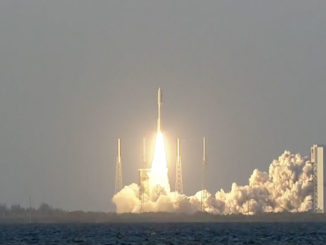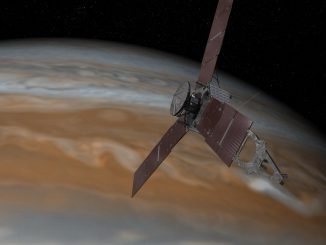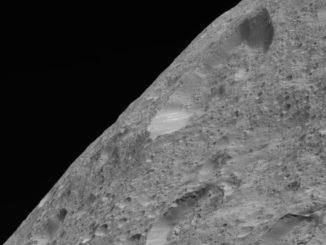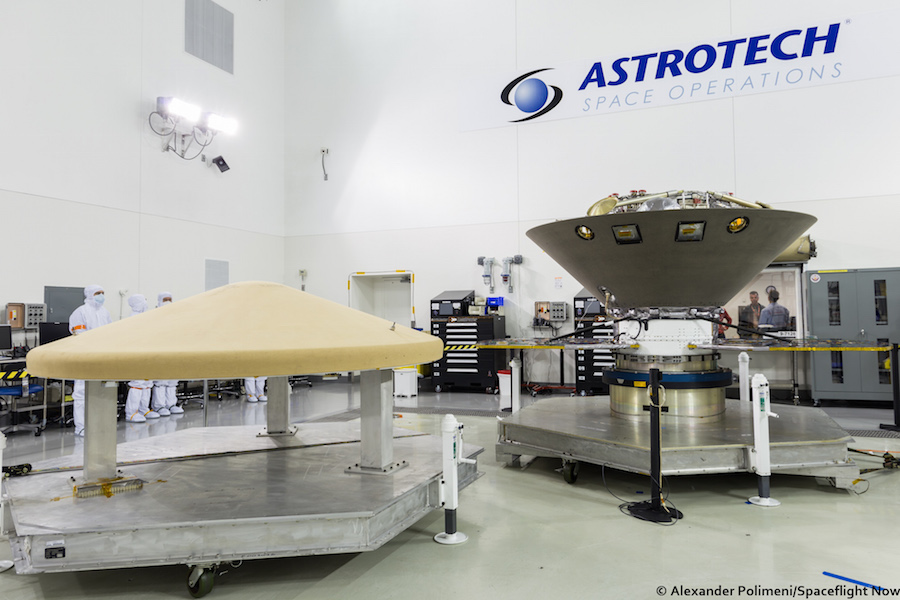
NASA’s InSight Mars lander will be buttoned up for launch in the coming weeks at Vandenberg Air Force Base in California, in preparation for its hoisting atop an Atlas 5 rocket for blastoff in the predawn hours of May 5.
The Lockheed Martin-built spacecraft has completed a series of checkouts since arriving at Vandenberg, a military base located northwest of Los Angeles, on Feb. 28. Engineers removed the InSight lander’s heat shield for final electronics testing and fueling.
With fuel for its control thrusters and landing rockets now loaded, and launch less than four weeks away, ground crews inside the Astrotech spacecraft processing facility at Vandenberg will re-install the heat shield, lift the spacecraft on top of the Atlas 5’s payload attach fitting, then encapsulate the probe inside the Atlas 5’s nose shroud.
Once cocooned inside the payload fairing, InSight will be transported to Space Launch Complex 3-East at Vandenberg, where cranes will hoist the spacecraft on top of the Atlas 5 launcher already assembled at the pad inside a mobile service tower.
ULA’s launch team completed a fueling test and countdown rehearsal on the Atlas 5 rocket last month. Such tests, called “wet dress rehearsals,” are not part of a normal Atlas 5 launch campaign, but officials ordered the operation as an extra step to ensure the rocket is ready for InSight’s 34-day launch period.
Liftoff is scheduled for May 5 during a two-hour launch window opening at 4:05 a.m. PDT (7:05 a.m. EDT; 1105 GMT).
InSight has until June 8 to launch from Vandenberg, when the ever-changing positions of Earth and Mars in the solar system make a direct trip possible. Mars launch opportunities come once every 26 months.
The lander will arrive at Mars on Nov. 26, regardless of the launch date from May 5 through June 8.
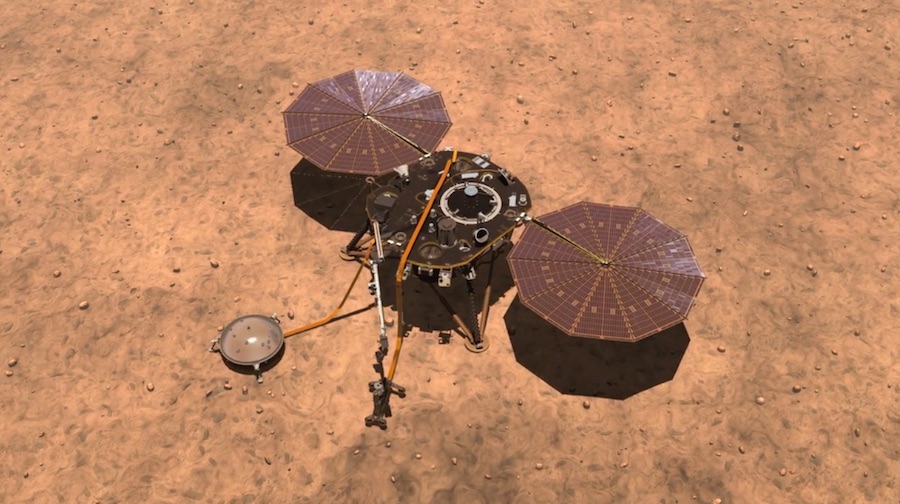
InSight will be the first mission to another planet to lift off from the U.S. West Coast. Vandenberg Air Force Base is typically host to launches into polar orbit, a type of orbit usually tailored for climate research missions, spy satellites and some communication applications.
NASA’s interplanetary probes are usually reserved for launches from Cape Canaveral, where rockets take off toward the east over the Atlantic Ocean for safety reasons. A launch toward the east gains an extra boost from the speed of Earth’s rotation, allowing a rocket to carry a heavier payload.
But InSight is small — it will weigh around 1,530 pounds (694 kilograms) at launch — well below the lift capability of the United Launch Alliance Atlas 5 rocket, which will fly in its basic “401” configuration with a four-meter payload fairing and no solid rocket boosters.
That means the Atlas 5 will not need the extra energy imparted during an eastward launch from Cape Canaveral, and ULA and NASA agreed to launch InSight from Vandenberg. Fewer Atlas 5 missions are scheduled from Vandenberg, so officials wanted to reduce the workload at ULA’s busier launch base in Florida.
Designers based the InSight lander on NASA’s Phoenix probe, which launched in August 2007 and touched down on the northern polar plains of Mars in May 2008. Diminishing solar power and cold temperatures limited Phoenix’s lifetime to about five months — two months longer than its three-month prime mission.
InSight will head for a broad plain near the Martian equator with ample sunlight year-round. Officials selected the landing site in Elysium Planitia for its safety — there are few steep slopes or huge boulders. Bruce Banerdt, InSight’s principal investigator at NASA’s Jet Propulsion Laboratory, calls it “the biggest parking lot on Mars.”
No mission has landed at Elysium Planitia before, but NASA’s Curiosity rover — the last U.S. craft to land on Mars in 2012 — is exploring Gale Crater nearly 400 miles (600 kilometers) to the south.
Scientists usually want to send Mars landers to places that show evidence of ancient water flows, allowing instruments to study whether the red planet may have once harbored life.
But InSight’s scientific objectives go deeper.
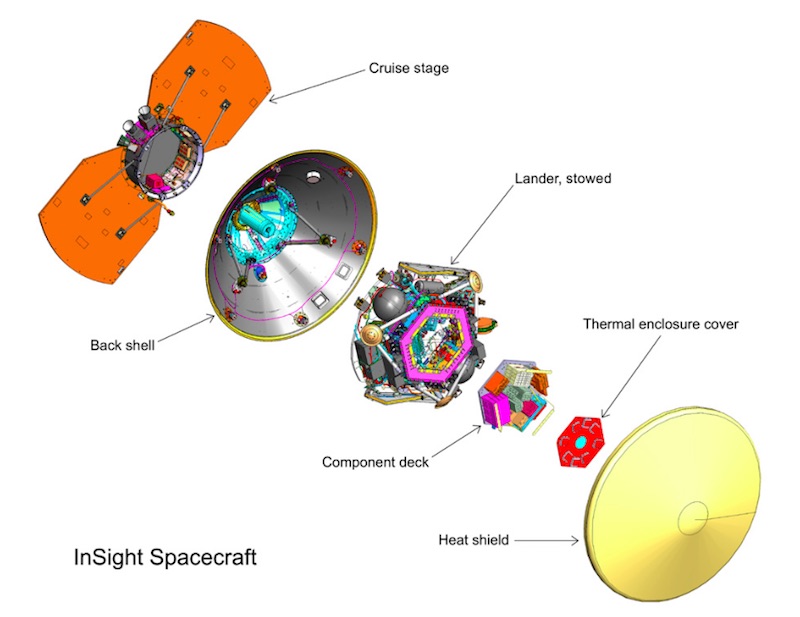
Two instruments carried aboard the lander will study the Martian interior, listening for tremors and measuring heat coming from the planet’s deep mantle and core. Scientists will also measure Mars’ polar wobble by analyzing radio signals transmitted between InSight and Earth-based antennas.
“In essence, it will take the vital signs of Mars — its pulse, temperature and much more,” said Thomas Zurbuchen, head of NASA’s science division. “We like to say it’s the first thorough checkup since the planet formed four-and-a-half billion years ago.”
Much of the ancient geologic record on Earth has eroded away, but Mars may still hold clues about how it was born, accreted rock and dust, and formed a hot, high-pressure mantle and core as heavier elements sunk deep beneath its surface.
“How we get from a ball of featureless rock into a planet that may or may not support life is a key question in planetary science,” Banerdt said. “And these processes that do this all happen in the first tens of millions of years.”
Discoveries made by InSight at Mars could inform scientists how the Earth formed and evolved.
“Mars is a smaller planet,” Banerdt said. “It’s less active than the Earth, so it has retained the fingerprints of those early processes in its basic structure — the thickness of the crust, the compositon of the mantle, the size and composition of its core,” he said. “By mapping out these boundaries, these various different sections of the inside of the planet, we can then understand better how the planet formed, and how our planet got to be the way it is.”
The nearly $1 billion InSight mission carries a French-developed seismometer package and a German-built heat probe that will burrow to a depth of up to 16 feet (5 meters).
A nearly 8-foot-long (2.4-meter) robotic arm will place the seismometer and heat probe on the Martian surface next to the lander after touchdown. InSight’s robotic arm was originally built for the canceled Mars Surveyor lander that was supposed to launch in 2001.
Officials hoped to launch InSight in March 2016, but problems testing the seismometer instrument forced a delay until the next Mars launch opportunity this year.
InSight’s primary mission is expected to last more than a Martian year — or nearly two Earth years — through November 2020.
“This is something that I’ve dreamed about, and developed my career to, for 30 years now,” Banerdt said. “We’ve been trying to refine this mission concept and get it ready to go, and finally we’re right on the verge of taking off for Mars.”
The photos below were taken Friday inside the Astrotech clean room at Vandenberg, showing the InSight lander inside its aerodynamic backshell and mated to the craft’s cruise stage, which will steer the probe toward Mars after its launch May 5.
The cruise stage’s power-generating solar panels will be launched in the extended configuration seen in these photos. Shortly before arriving at Mars, the cruise stage will separate from the entry vehicle and burn up in the Martian atmosphere, while the InSight lander makes its final ascent with the assistance of a supersonic parachute and braking thrusters.
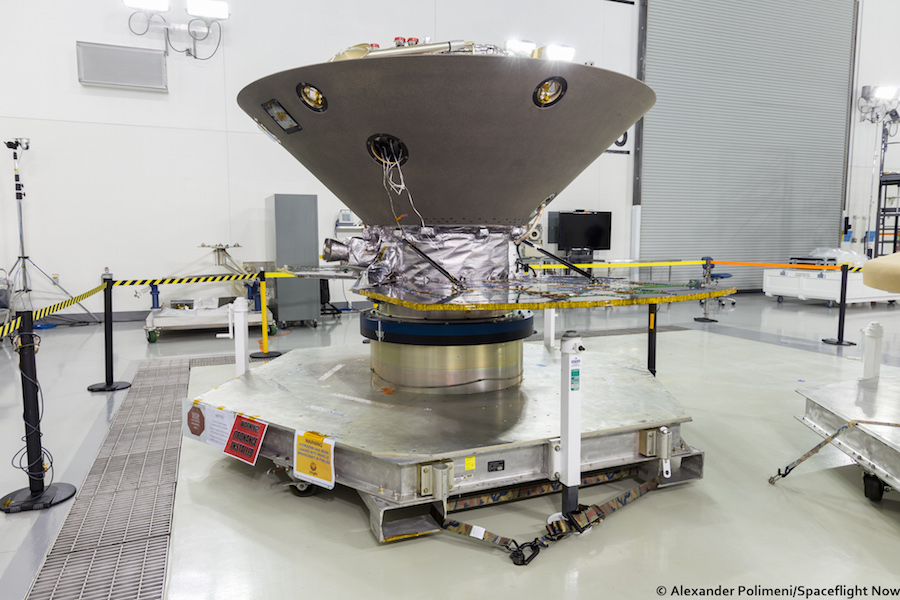
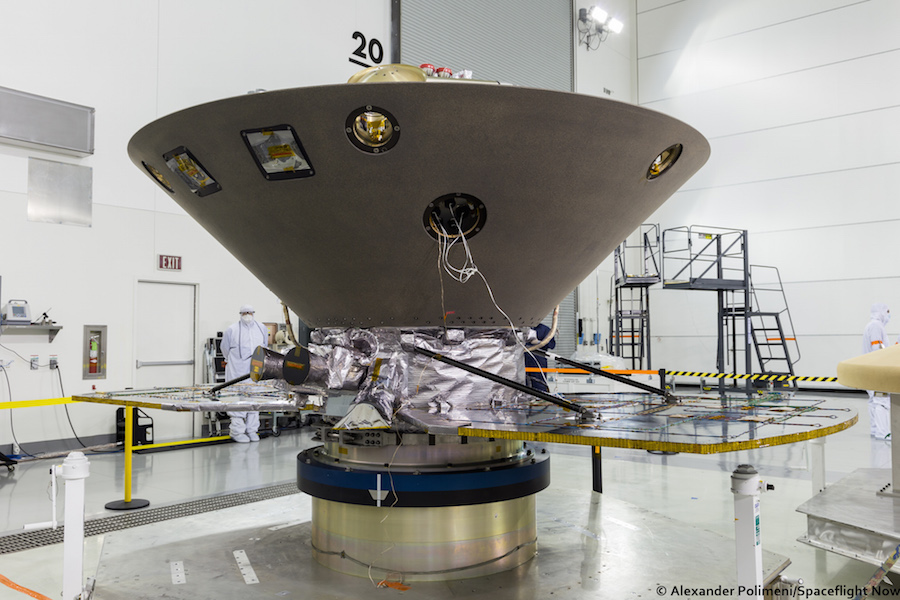
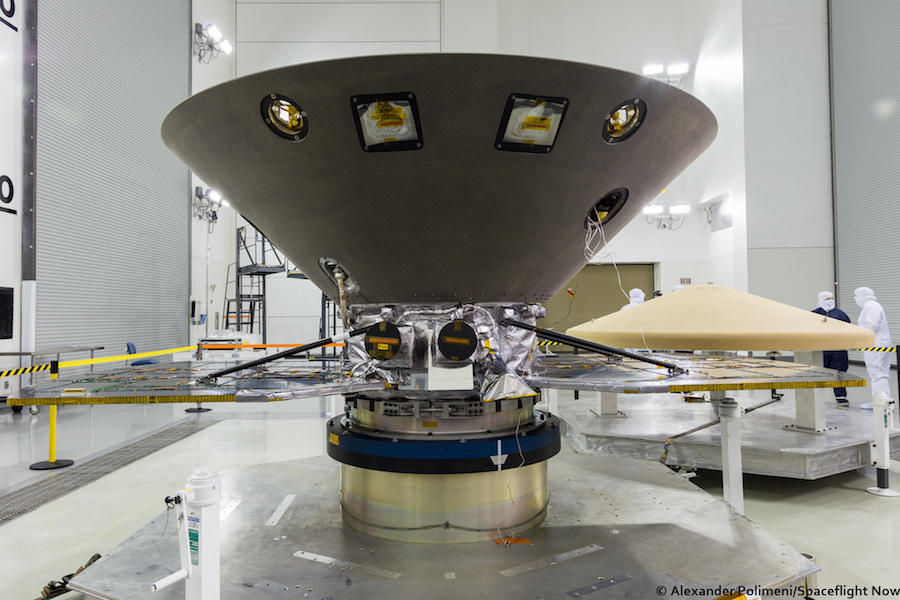
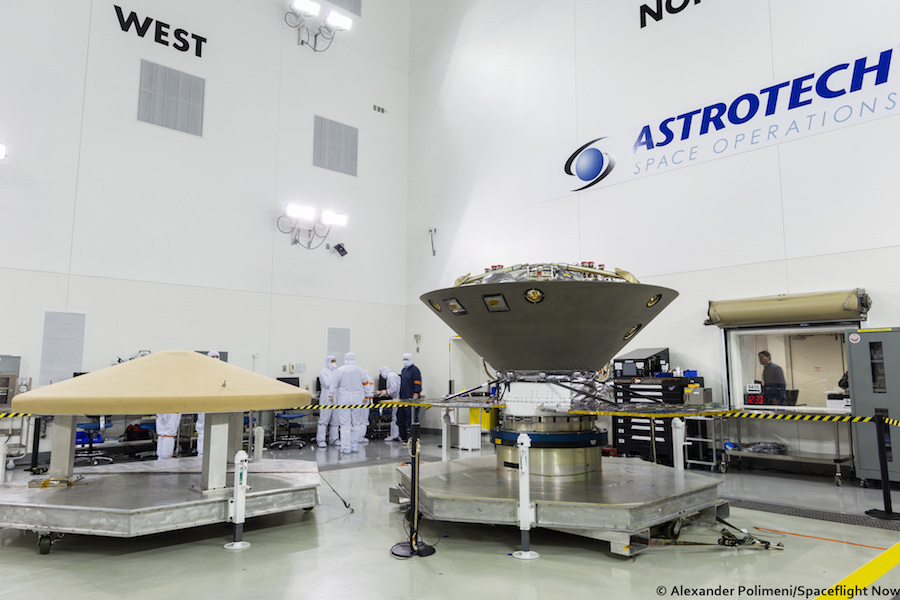
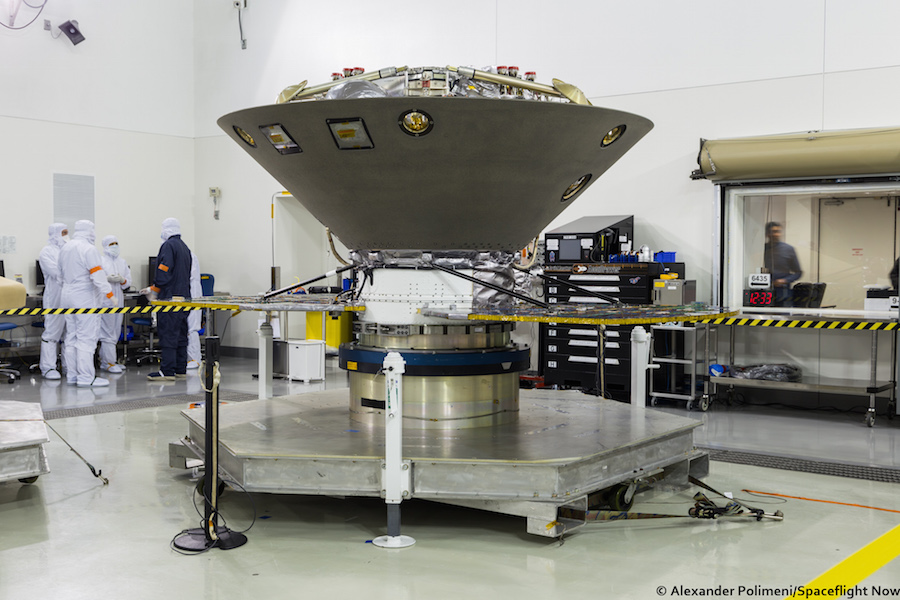
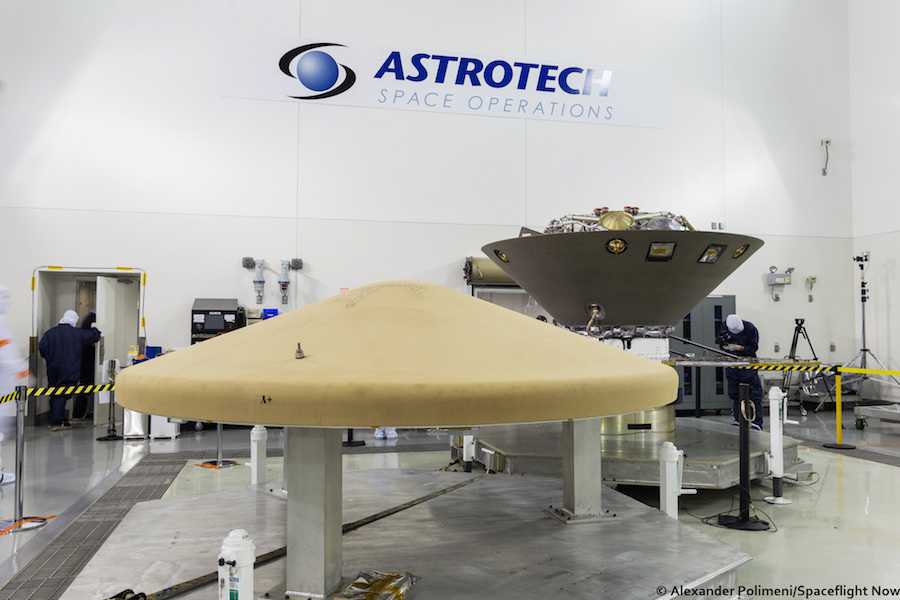
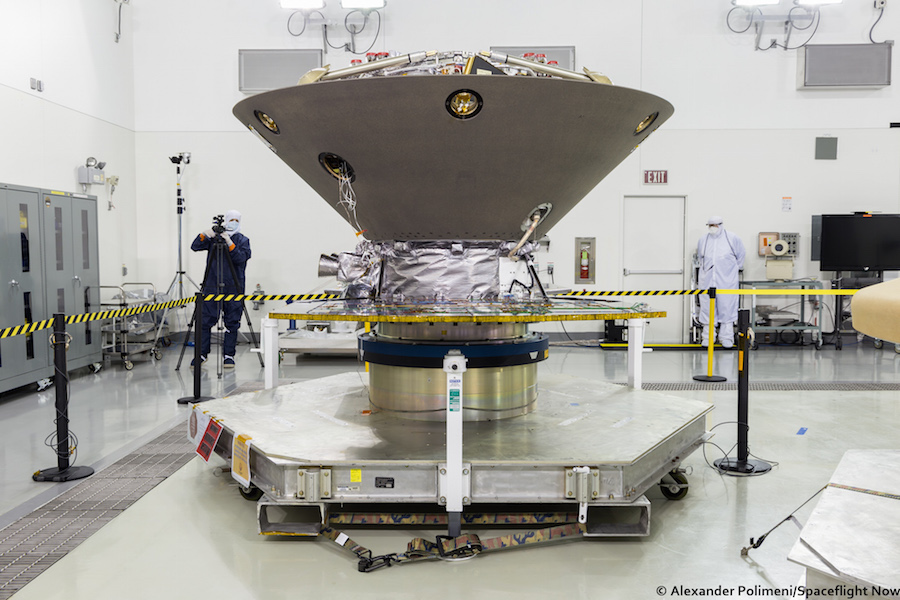
Email the author.
Follow Stephen Clark on Twitter: @StephenClark1.

